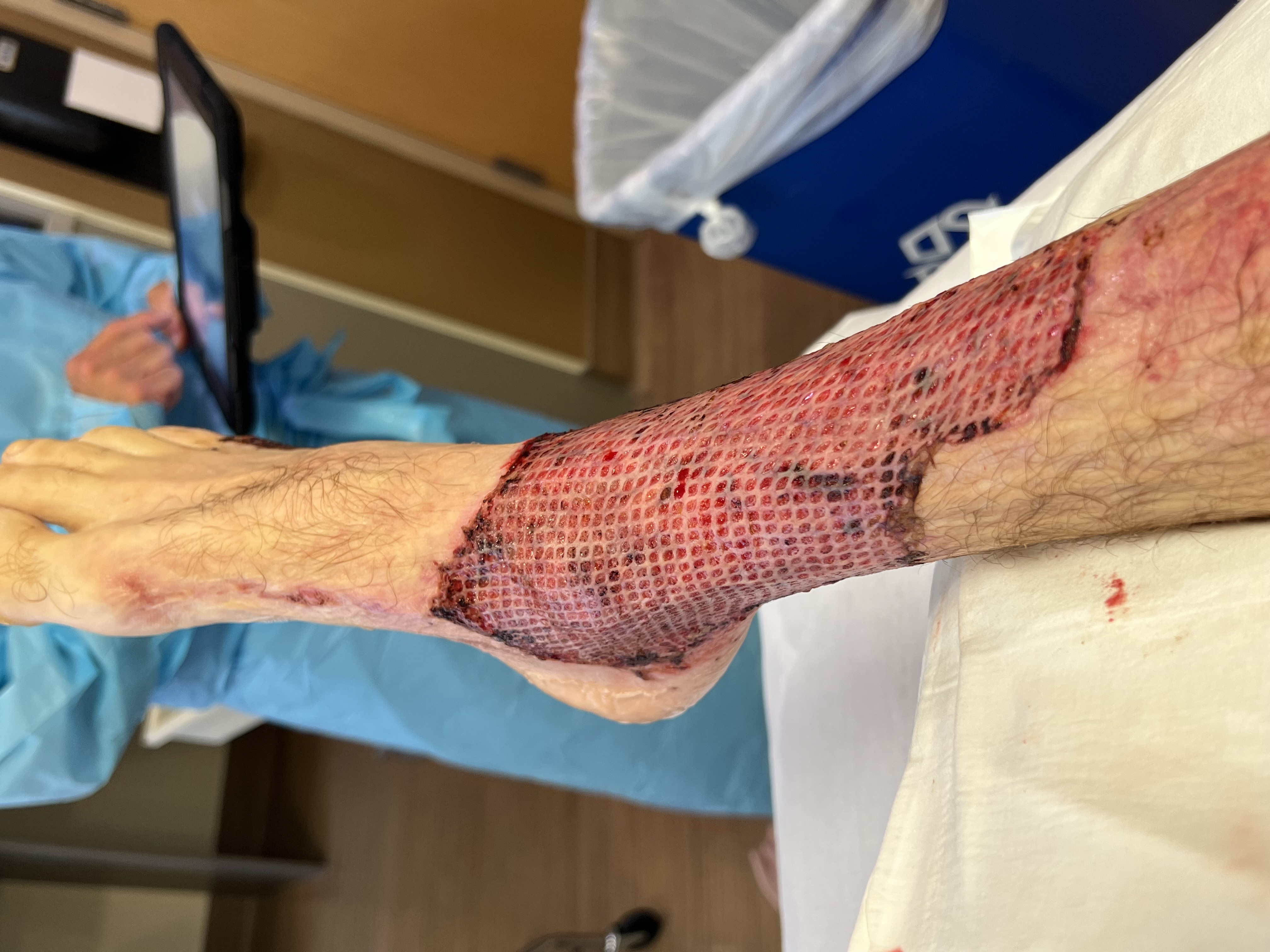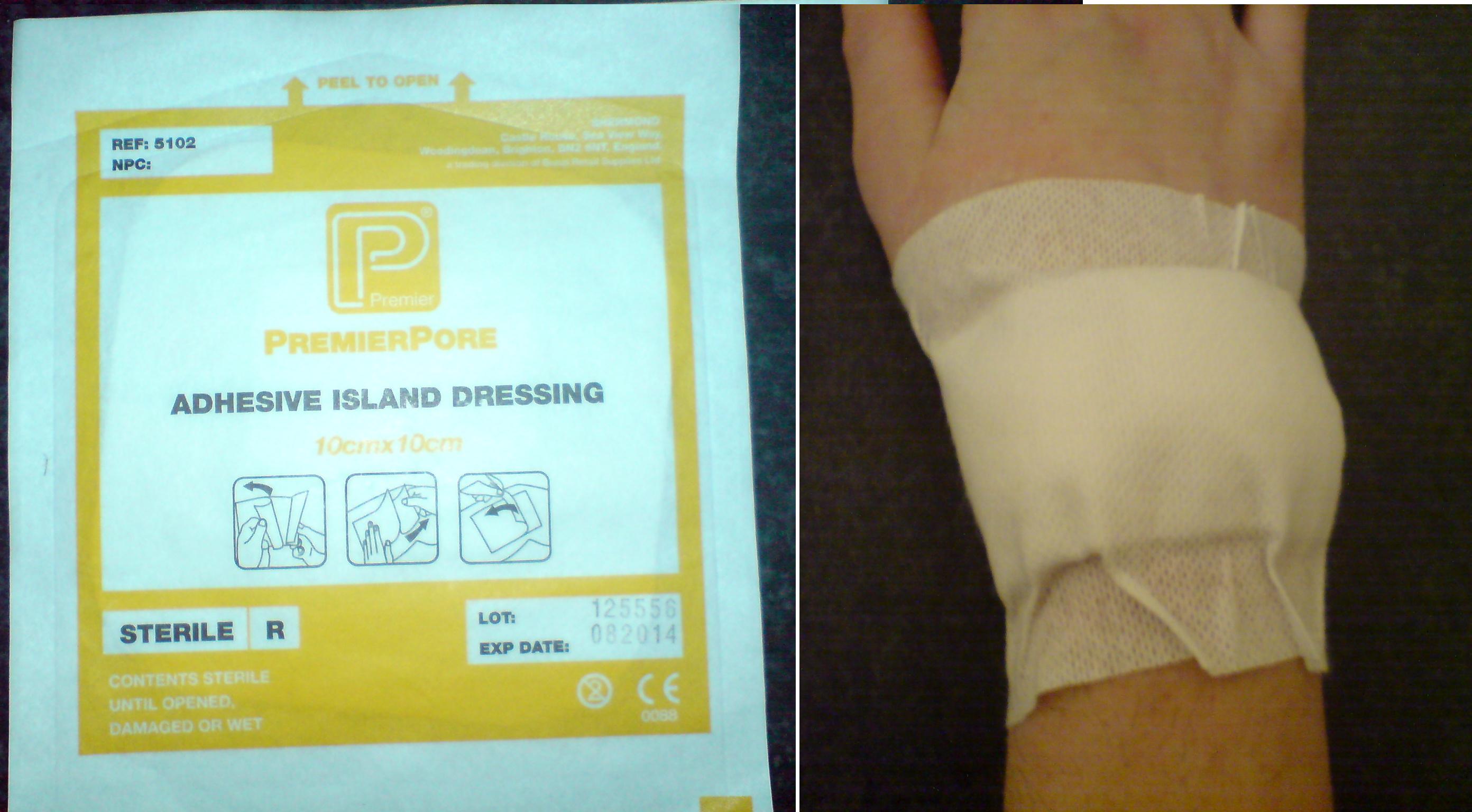|
Burn
A burn is an injury to skin, or other tissues, caused by heat, cold, electricity, chemicals, friction, or ultraviolet radiation (like sunburn). Most burns are due to heat from hot liquids (called scalding), solids, or fire. Burns occur mainly in the home or the workplace. In the home, risks are associated with domestic kitchens, including stoves, flames, and hot liquids. In the workplace, risks are associated with fire and chemical and electric burns. Alcoholism and smoking are other risk factors. Burns can also occur as a result of self-harm or violence between people (assault). Burns that affect only the superficial skin layers are known as superficial or first-degree burns. They appear red without blisters and pain typically lasts around three days. When the injury extends into some of the underlying skin layer, it is a partial-thickness or second-degree burn. Blisters are frequently present and they are often very painful. Healing can require up to eight weeks and sc ... [...More Info...] [...Related Items...] OR: [Wikipedia] [Google] [Baidu] |
Sunburn
Sunburn is a form of radiation burn that affects living tissue, such as skin, that results from an overexposure to ultraviolet (UV) radiation, usually from the Sun. Common symptoms in humans and animals include: red or reddish skin that is hot to the touch or painful, general fatigue, and mild dizziness. Other symptoms include blistering, peeling skin, swelling, itching, and nausea. Excessive UV radiation is the leading cause of (primarily) non-malignant skin tumors,World Health Organization, International Agency for Research on Cance"Do sunscreens prevent skin cancer" Press release No. 132, 5 June 2000World Health Organization, International Agency for Research on Cance"Solar and ultraviolet radiation"IARC Monographs on the Evaluation of Carcinogenic Risks to Humans, Volume 55, November 1997 and in extreme cases can be life-threatening. Sunburn is an inflammatory response in the tissue triggered by direct DNA damage by UV radiation. When the cells' DNA is overly damage ... [...More Info...] [...Related Items...] OR: [Wikipedia] [Google] [Baidu] |
Injury
An injury is any physiological damage to living tissue caused by immediate physical stress. An injury can occur intentionally or unintentionally and may be caused by blunt trauma, penetrating trauma, burning, toxic exposure, asphyxiation, or overexertion. Injuries can occur in any part of the body, and different symptoms are associated with different injuries. Treatment of a major injury is typically carried out by a health professional and varies greatly depending on the nature of the injury. Traffic collisions are the most common cause of accidental injury and injury-related death among humans. Injuries are distinct from chronic conditions, psychological trauma, infections, or medical procedures, though injury can be a contributing factor to any of these. Several major health organizations have established systems for the classification and description of human injuries. Occurrence Injuries may be intentional or unintentional. Intentional injuries may be acts of ... [...More Info...] [...Related Items...] OR: [Wikipedia] [Google] [Baidu] |
Burn Center
A burn center, burn unit, or burns unit is a hospital specializing in the treatment of burns. Burn centers are often used for the treatment and recovery of patients with more severe burns. Overview The severity of a burn, and therefore whether a referral will be made after the patient is treated and stabilized, differs depending upon many factors, among them: the age of the victim (burns to infants and toddlers or to those over age 65 are generally more serious, particularly if the face, head, respiratory system, chest, abdomen, groin, or extremities are burned; those who are not in these age groups can be more affected if they are or were already ill, injured, or immunocompromised), the total body surface area that is burned (the rule of nines), if proper treatment and referrals are delayed or the wrong treatments are given, if the burns are of the 2nd, 3rd, or 4th degree (the bigger and deeper, the worse it is), the source (if it was due to a chemical, or from a scald, or fi ... [...More Info...] [...Related Items...] OR: [Wikipedia] [Google] [Baidu] |
Scalding
Scalding is a form of thermal burn resulting from heated fluids such as boiling water or steam. Most scalds are considered first- or second-degree burns, but third-degree burns can result, especially with prolonged contact. The term is from the Latin word ''calidus'', meaning hot. Causes Most scalds result from exposure to high-temperature water, such as tap water in baths and showers, water heaters, or cooking water, or from spilled hot drinks, such as coffee. Scalds can be more severe when steam impinges on the naked skin, because steam can reach higher temperatures than water and transfers latent heat by condensation. On the other hand, when clothes are soaked with hot water the heat transfer is often of a longer duration since the body part cannot be removed from the heat source as quickly. Temperatures The temperature of tap water should not exceed to prevent discomfort and scalding. However, it is necessary to keep warm water at a temperature of to inhibit the gr ... [...More Info...] [...Related Items...] OR: [Wikipedia] [Google] [Baidu] |
Blisters
A blister is a small pocket of body fluid ( lymph, serum, plasma, blood, or pus) within the upper layers of the skin, usually caused by forceful rubbing ( friction), burning, freezing, chemical exposure or infection. Most blisters are filled with a clear fluid, either serum or plasma. However, blisters can be filled with blood (known as " blood blisters") or with pus (for instance, if they become infected). The word "blister" entered English in the 14th century. It came from the Middle Dutch and was a modification of the Old French , which meant a leprous nodule—a rise in the skin due to leprosy. In dermatology today, the words ''vesicle'' and ''bulla'' refer to blisters of smaller or greater size, respectively. To heal properly, a blister should not be popped unless medically necessary. If popped, the bacteria can spread. The excess skin should not be removed because the skin underneath needs the top layer to heal properly. Causes A blister may form when the ski ... [...More Info...] [...Related Items...] OR: [Wikipedia] [Google] [Baidu] |
Plastic Surgery
Plastic surgery is a surgical specialty involving the restoration, reconstruction or alteration of the human body. It can be divided into two main categories: reconstructive surgery and cosmetic surgery. Reconstructive surgery includes craniofacial surgery, hand surgery, microsurgery, and the treatment of burns. While reconstructive surgery aims to reconstruct a part of the body or improve its functioning, cosmetic (or aesthetic) surgery aims at improving the appearance of it. Etymology The word ''plastic'' in ''plastic surgery'' means "reshaping" and comes from the Greek πλαστική (τέχνη), ''plastikē'' (''tekhnē''), "the art of modelling" of malleable flesh. This meaning in English is seen as early as 1598. The surgical definition of "plastic" first appeared in 1839, preceding the modern "engineering material made from petroleum" sense by 70 years. History Treatments for the plastic repair of a broken nose are first mentioned in the Egyptian medical ... [...More Info...] [...Related Items...] OR: [Wikipedia] [Google] [Baidu] |
Scarring
A scar (or scar tissue) is an area of fibrous tissue that replaces normal skin after an injury. Scars result from the biological process of wound repair in the skin, as well as in other organs, and tissues of the body. Thus, scarring is a natural part of the healing process. With the exception of very minor lesions, every wound (e.g., after accident, disease, or surgery) results in some degree of scarring. An exception to this are animals with complete regeneration, which regrow tissue without scar formation. Scar tissue is composed of the same protein (collagen) as the tissue that it replaces, but the fiber composition of the protein is different; instead of a random basketweave formation of the collagen fibers found in normal tissue, in fibrosis the collagen cross-links and forms a pronounced alignment in a single direction. This collagen scar tissue alignment is usually of inferior functional quality to the normal collagen randomised alignment. For example, scars in the s ... [...More Info...] [...Related Items...] OR: [Wikipedia] [Google] [Baidu] |
Skin Grafting
Skin grafting, a type of graft surgery, involves the transplantation of skin. The transplanted tissue is called a skin graft. Surgeons may use skin grafting to treat: * extensive wounding or trauma * burns * areas of extensive skin loss due to infection such as necrotizing fasciitis or purpura fulminans * specific surgeries that may require skin grafts for healing to occur - most commonly removal of skin cancers Skin grafting often takes place after serious injuries when some of the body's skin is damaged. Surgical removal (excision or debridement) of the damaged skin is followed by skin grafting. The grafting serves two purposes: reducing the course of treatment needed (and time in the hospital), and improving the function and appearance of the area of the body which receives the skin graft. There are two types of skin grafts: * The more common type involves removing a thin layer of skin from a healthy part of the body (the donor section) - like peeling a potato. * A f ... [...More Info...] [...Related Items...] OR: [Wikipedia] [Google] [Baidu] |
Kitchen Stove
A kitchen stove, often called simply a stove or a cooker, is a kitchen appliance designed for the purpose of cooking food. Kitchen stoves rely on the application of direct heat for the cooking process and may also contain an oven, used for baking. "Cookstoves" (also called "cooking stoves" or "wood stoves") are heated by burning wood or charcoal; "gas stoves" are heated by gas; and "electric stoves" by electricity. A stove with a built-in cooktop is also called a range. In the industrialized world, as stoves replaced open fires and braziers as a source of more efficient and reliable heating, models were developed that could also be used for cooking, and these came to be known as ''kitchen stoves''.Montagne, Prosper ''New Larousse Gastronomique'' Hamlin Publishing Group 1977 268,901 Quoting Eugène Viollet-le-Duc on cooking in the Middle Ages: "The division of stoves into several compartments as in our day was seldom seen. The dishes were cooked on the fire itself, and these f ... [...More Info...] [...Related Items...] OR: [Wikipedia] [Google] [Baidu] |
Self-harm
Self-harm is intentional behavior that is considered harmful to oneself. This is most commonly regarded as direct injury of one's own skin tissues usually without a suicidal intention. Other terms such as cutting, self-injury and self-mutilation have been used for any self-harming behavior regardless of suicidal intent. It is not the same as masochism, as no sexual or nonsexual pleasure is obtained. The most common form of self-harm is using a sharp object to cut the skin. Other forms include scratching, hitting, or burning body parts. While earlier usage included interfering with wound healing, excessive skin-picking, hair-pulling, and the ingestion of toxins, current usage distinguishes these behaviors from self-harm. Likewise, tissue damage from drug abuse or eating disorders is not considered self-harm because it is ordinarily an unintended side-effect but context may be needed as intent for such acts varies. Although self-harm is by definition non-suicidal, it may still ... [...More Info...] [...Related Items...] OR: [Wikipedia] [Google] [Baidu] |
Critical Care Medicine
Intensive care medicine, also called critical care medicine, is a medical specialty that deals with seriously or critically ill patients who have, are at risk of, or are recovering from conditions that may be life-threatening. It includes providing life support, invasive monitoring techniques, resuscitation, and end-of-life care. Doctors in this specialty are often called intensive care physicians, critical care physicians or intensivists. Intensive care relies on multidisciplinary teams composed of many different health professionals. Such teams often include doctors, nurses, physical therapists, respiratory therapists, and pharmacists, among others. They usually work together in intensive care units (ICUs) within a hospital. Scope Patients are admitted to the intensive care unit if their medical needs are greater than what the general hospital ward can provide. Indications for the ICU include blood pressure support for cardiovascular instability ( hypertension/ hypot ... [...More Info...] [...Related Items...] OR: [Wikipedia] [Google] [Baidu] |
Dressing (medical)
A dressing is a sterile pad or compress applied to a wound to promote healing and protect the wound from further harm. A dressing is designed to be in direct contact with the wound, as distinguished from a bandage, which is most often used to hold a dressing in place. Many modern dressings are self-adhesive. Medical uses A dressing can have a number of purposes, depending on the type, severity and position of the wound, although all purposes are focused on promoting recovery and protecting from further harm. Key purposes of a dressing are: * Stop bleeding – to help to seal the wound to expedite the clotting process; * Protection from infection – to defend the wound against germs and mechanical damage; * Absorb exudate – to soak up blood, plasma, and other fluids exuded from the wound, containing it/them in one place and preventing maceration; * Ease pain – either by a medicated analgesic effect, compression or simply preventing pain from further trauma; * Debride ... [...More Info...] [...Related Items...] OR: [Wikipedia] [Google] [Baidu] |



.jpg)



